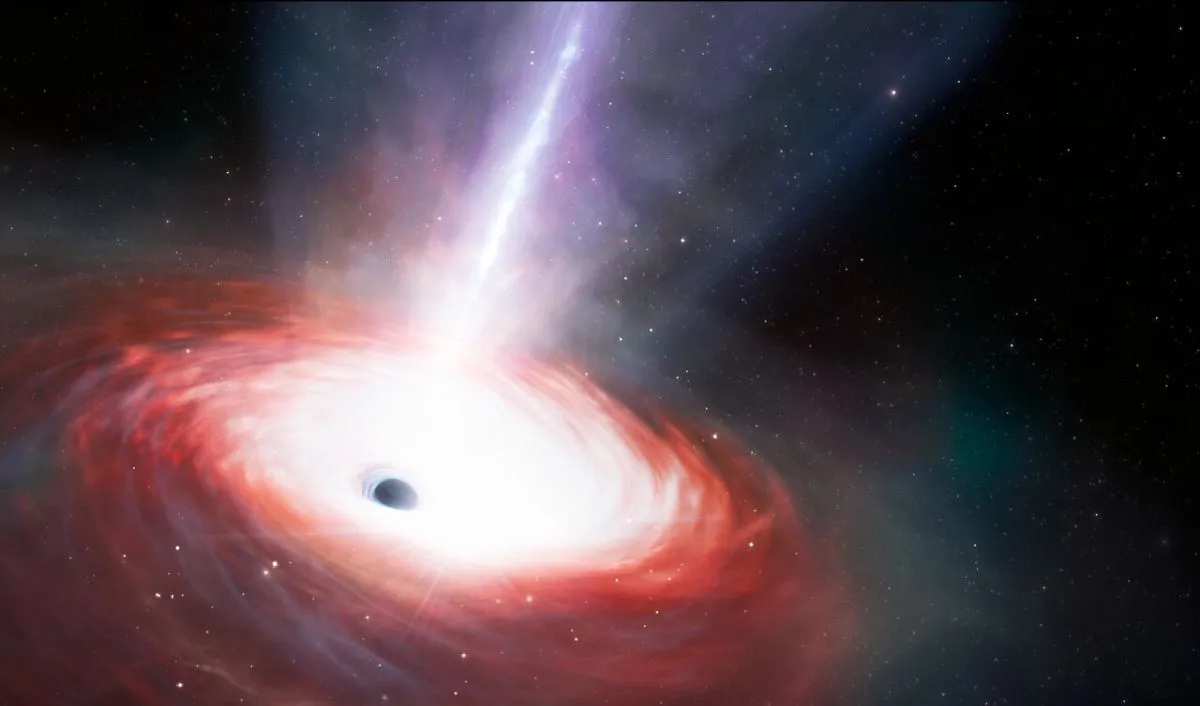Peering back into the early years of the universe requires scientists to make a lot of assumptions. But sometimes, we get better instruments that then allow them to either confirm or replace those assumptions. That happened recently when it came to our study of J0529, a supermassive black hole that is currently the brightest known quasar in the universe. A new paper from a massive team of researchers used the GRAVITY+ instrument on the European Southern Observatory’s (ESO’s) Very Large Telescope (VLT) Interferometer to map this unique object’s Broad Line Region (BLR), and thereby calculated a new, updated mass that is 10 times smaller than previous estimates.
To put it into perspective, that mass is still 800 million times the mass of our Sun. But why such a huge discrepancy between the original estimate of 10 billion solar masses and the new one? A better technology, in this case the VLT’s interferometer, disproved a common assumption that the original research team that found J0529 had made, and that has bigger implications for our understanding of black hole sizes, especially early on in the universe.
Previously, a standard way to calculate a black hole’s mass was to approximate it by taking the square of the orbital velocity of the accretion disc surrounding the black hole and multiplying it by the distance to the black hole. When J0529 was discovered in 2024, researchers knew the distance - about 12.5 billion light years away, when the universe itself was only 1.5 billion years old. And they thought they could measure the orbital velocity of the accretion disc by measuring the width of its emission lines.
Fraser explains quasarsEmission lines are the spectral signal coming from the light emitted by the superheated gas and dust in the accretion disc. The standard calculation of their orbital velocity relies on a fundamental assumption that a “broader” emission line, the faster the gas is orbiting. It would be broad because it would reflect material that is moving both towards us (blueshifted) and away from us (redshifted). The faster its moving, the more the lines are shifted, hence a “broader” profile in the data. Since J0529 had an extremely broad emission line, it was assumed that the gas must be moving quickly, and hence the supermassive black hole at its center must be extraordinarily large to make the gas be moving that quickly.
Using the GRAVITY+ instrument, which acts as an interferometer and significantly increases the observational power of the VLT by combining the light from all four 8-meter telescopes into a single “virtual” one, the researchers were able to directly see the Broad Line Region (BLR) around J0529 - the area of clouds orbiting the supermassive black hole. In that image, they saw a massive jet of gas shooting away from the black hole at 10,000 km/s. This might seem counterintuitive, as black holes are commonly thought to absorb everything around them and nothing escapes.
However, their gravitational pull can cause massive disruptions in the material in the accretion disc, so that, before the material can enter the black holes event horizon, it is ejected at astonishing speeds. And since the speed the accretion disc is orbiting the black hole is a main component in calculating its mass, such jets can also skew the measurements of their host black hole masses.
Artist's impression of J0529. Credit - ESO/M. KornmesserThat is exactly what happened in the case of J0529. The 10,000 km/s jet massively broadened the spectral lines the original researchers were looking at, and they assumed that the extremely broad lines coming from J0529 were being caused by extreme orbital speeds rather than outflows that have no bearing on the mass of the black hole.
Once the outflows were spatially observed, the researchers were able to subtract their value from the spectral lines and recalculate the mass of J0529, which resulted in a mass only about 10% of the original estimate. But again, to put in perspective, J0529 is still 800 million times the size of our Sun.
The study also lends some additional evidence to some thorny problems in astrophysics, such as how supermassive black holes can grow to billions of times the size of the Sun only few hundred million years after the big bang. The bright outflow jets of J0529 are being fed by a process called Super-Edditing Accretion, where an exceeds it’s “Eddington Limit”, the maximum brightness at which an object can shine given its mass that won’t blow away the material that is causing it to grow.
ESO provides more details about J0529. Credit - ESO YouTube ChannelA black hole can grow past its Eddington limit for a period of time, but in doing so it will sacrifice some of its overall size in the long run, as material that would otherwise contribute to its mass would be blown away by pressure from its own light. The same jets that are blown out like that can have a major impact on the formation of galaxies, as they can stop star formation in their path as well as disperse the material to other galaxies outside the one that created the jet.
As we get more powerful telescopes, we’ll be able to get an even closer picture of what is happening in these far-away galaxies. And hopefully those pictures will allow us both to check our assumptions about what we know about the universe, but also provide new insight into what we might be able to find out there. That’s part of the reason why the cycle of technological progress enabling scientific discovery is so powerful.
Learn More:
ANU - New technology takes kilos off early universe’s supermassive black holes
GRAVITY+ Collaboration et al. - Spatially resolved broad line region in a quasar at z=4: Dynamical black hole mass and prominent outflow
UT - The Brightest Object Ever Seen in the Universe
UT - Two Quasars From the Early Universe Provide Clues About Galactic Evolution
 Universe Today
Universe Today
